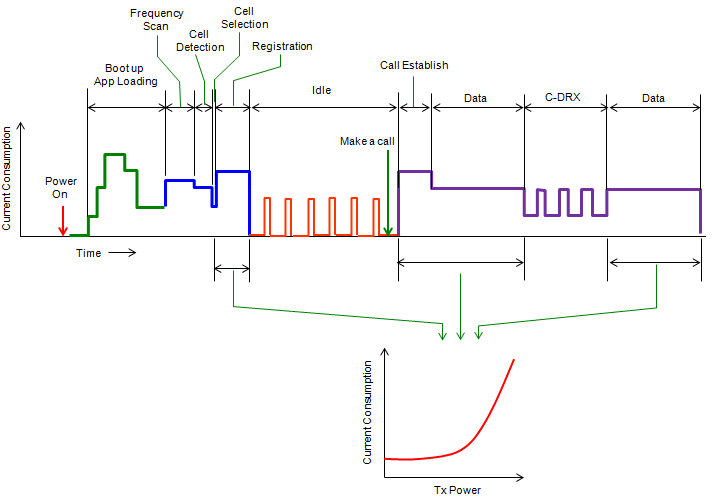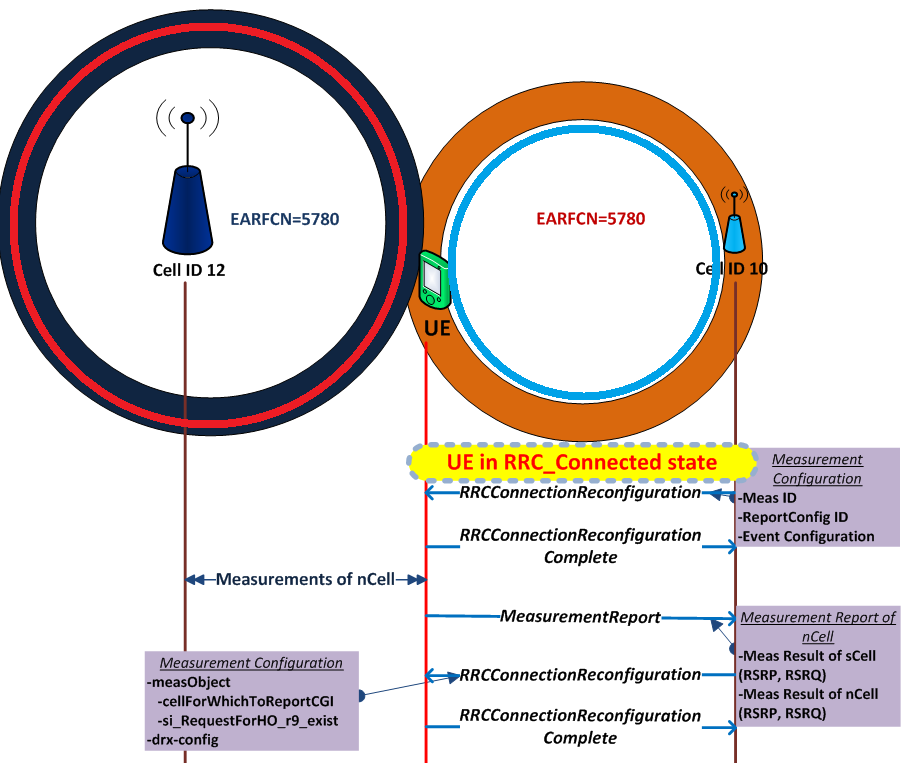Telecom Made Simple: Paging

Get LTE Basics here…
What is DRX switch?
Switch Access lets you interact with your Android device using one or more switches instead of the touchscreen. Switch Access can be helpful for people with dexterity impairments that prevent them from interacting directly with the Android device.
In some embodiments, the extended awake period may be added after the activities of the second subscription. That is, after the activities of the second subscription, the RF resource may be tuned back to the first subscription for the extended awake period. Accordingly, the first subscription may have an opportunity to monitor for downlink data within the same CDRX cycle, instead of sleeping until the awake period of the next CDRX cycle. In some embodiments, the processor is configured to extend the inactivity timer duration for the extended inactivity timer duration by configuring a RF resource of the wireless communication device to monitor downlink data in a PDSCH during the extended inactivity timer duration. In response to determining at least a portion of an inactivity timer duration (corresponding to the inactivity timer) collides with activities of the second subscription, the inactivity timer duration may be extended.
Thus, LTE data throughput may be degraded since the UE misses PDCCH grants scheduled for it. The controller/processor can be associated with a memory 660 that stores program codes and data.
Supporting machine-to-machine communications in long-term evolution networks
What is HARQ RTT timer?
HARQ RTT Timer specifies the minimum amount of subframe(s) duration from the time new transmission is received and before the UE can expect a retransmission of the same packet. This timer is fixed and not configured by RRC.
The method of claim 16, further comprising monitoring downlink data in a Physical Downlink Shared Channel (PDSCH) during the inactivity timer duration. Other techniques include polling, whereby the device is placed into standby for a given amount of time and then a beacon is sent by the access point or base station periodically which indicates if there is any waiting data for it. This is used in 802.11 wireless networks when compatible access cards and access points negotiate a power saving mode arrangement.
UE 1 10 may perform registration with the serving network, if necessary. UE 110 may then operate in a connected mode to actively communicate with the serving network. Alternatively, UE 1 10 may operate in an idle mode and camp on the serving network if active communication is not required by UE 110.
10, in a second scenario, the UE may successfully decode PDCCH at tl, initiate the inactivity timer at t2, and tune away from the LTE network at t3. At t4, the inactivity timer may expire during the tune away gap. At 806, the UE may determine when an inactivity timer for the DRX mode expires or will expire. AT 808, the UE may adjust a value of the inactivity timer based, at least in part, on the determination. Since the UE ignores the PDCCH grants during the CDRX Off state, the UE will not receive any downlink PDCCH grants (even though PDCCH grants may be scheduled by the eNB) until the next CDRX ON period of the CDRX cycle.
Upon power up, UE 110 may search for wireless networks from which it can receive communication services. If more than one wireless network is cdrx lte detected, then a wireless network with the highest priority may be selected to serve UE 110 and may be referred to as the serving network.

WO2016019112A1 – Long term evolution (lte) connected discontinuous reception (cdrx) for single-radio hybrid tune away devices – Google Patents
The controller/processor 659 is also responsible for HARQ operations, retransmission of lost packets, and signaling to the eNB 610. 6 is a block diagram of an eNB 610 in communication with a UE 650 cdrx lte in an access network. In the DL, upper layer packets from the core network are provided to a controller/processor 675. The controller/processor 675 implements the functionality of the L2 layer.
What is DRx in LTE?
In LTE, without Discontinuous Reception (DRX), the UE has to be awake all the time in order to decode downlink data, as the data in the downlink may arrive at any time. This means that UE has to be monitoring PDCCH in every subframe in order to check if there is downlink data available.
In LTE, an eNB may send a primary synchronization signal (PSS) and a secondary synchronization signal (SSS) for each cell in the eNB. The primary and secondary synchronization signals may be sent in symbol periods 6 and 5, respectively, in each of subframes 0 and 5 of each radio frame with the normal cyclic prefix (CP). The synchronization signals may be used by UEs for cell detection and acquisition. The eNB may send a Physical Broadcast Channel (PBCH) in symbol periods 0 to 3 in slot 1 of subframe 0.
- Putting it another way, it is a kind of MAC layer message from UE to Network (eNodeB) saying “I have something to transmit, would you give me a Grant to send this data ?” Then Network would allocate the bare minimum amount of UL Grant (Resources for PUSCH) if the resource is available.
- 10, and/or other processes for the techniques described herein, for example.
- UE 110 may remain camped on this frequency/RAT until either (i) the frequency/RAT is no longer available at a predetermined threshold or (ii) another frequency/RAT with a higher priority reaches this threshold.
- As long as the uplink is synchronized, uplink transmission of user data and L1/L2 control signaling is possible.
- There are somes cases where network send UL Grant when UE does not have any data to transmit, in this case UE transmit all 00 data or some garbage data and long padding 0s.
- By way of example, the machine-readable media may include a transmission line, a carrier wave modulated by data, and/or a computer product separate from the wireless node, all which may be accessed by the processor through the bus interface.
The UE may transmit only data or both data and control information in a physical UL shared channel (PUSCH) on the assigned resource blocks in the data section. A UL transmission may span both slots of a subframe and may hop across frequency.
Uplink transmission is not affected as UE can send SR in uplink whenever it wants i.e. UE is in DRX sleep period and it has uplink data so it will just wake up and send SR to receive UL grants from eNB. According to certain aspects, this may ensure that the UE is awake for until expiry of inactivity timer or until the end of the next on duration, whichever is shorter. This may address burst traffic models and a trade-off between UE current consumption and latency.
Tune-aways corresponding to the activities of the second subscription may have a higher priority than that of the awake period of the CDRX cycle. Thus, if the tune-away to the second subscription collides or overlaps with the awake period of the first subscription, the awake period may be interrupted or cut short in favor of tuning away to the second subscription. In response to determining that such a scenario has occurred, the wireless communication device may extend the awake period within the same CDRX cycle by adding an extended awake period.
thoughts on “DRx and RPh, Meaning, Fullform And Use”
One challenge with utilizing a single transmitter for multiple RAT communications is that, at times, there may be conflicts between scheduled uplink transmissions in both RATs. While the conflict may occur with an uplink transmission, the uplink transmission itself may result from a scheduled downlink transmission. For example, for scheduled LTE downlink transmissions, a UE may need to transmit an ACK in uplink to confirm it received the data. In other words, it is possible that a UE may be scheduled for uplink transmission in both RATs during given a transmission period.
UE receives the data and finds the HARQ process no. from PDCCH. If it were a retransmission, it performs soft combining of this data with the data stored in buffer last time. If it were http://cryptolisting.org/coin/ok/ a new transmission, it buffers the data and check CRC. If it has data to send and it has a grant it’ll send ul data alongwith ACK/NACK on PUSCH, otherwise it sends ACK/NACK on PUCCH.

In the DL, the controller/processor 675 provides header compression, ciphering, packet segmentation and reordering, multiplexing between logical and transport channels, and radio resource allocations to the UE 650 based on various priority metrics. what is pinkcoin The controller/processor 675 is also responsible for HARQ operations, retransmission of lost packets, and signaling to the UE 650. A UE may be assigned resource blocks 410a, 410b in the control section to transmit control information to an eNB.
PDCCH Order in LTE
What is LTE TTI?
TTI, Transmission Time Interval, is a parameter in UMTS (and other digital telecommunication networks) related to encapsulation of data from higher layers into frames for transmission on the radio link layer. At the receiver all bits from a given block must be received before they can be deinterleaved and decoded.
The controller/processor 659 is also responsible for error detection using an acknowledgement (ACK) and/or negative acknowledgement (NACK) protocol to support HARQ operations. In the UL, a data source 667 is used to provide upper layer packets to the controller/processor 659. The data source 667 represents all protocol layers above the L2 layer.
What is Paging in LTE?
DRX may not be as simple as you may expected because there should be well designed synchronization between UE and Network. In worst case, Network tries to send some data while UE is in sleep mode and UE tries cdrx lte to wake up when there is no data to be received. To prevent this kind of worst case scenario, UE and Network has a well defined agreement about when UE has to be in sleep mode and when UE has to wake up.
The memory 660 may be referred to as a computer-readable medium. In the UL, the control/processor 659 provides demultiplexing between transport and logical channels, packet reassembly, deciphering, header decompression, control signal processing to recover https://cryptolisting.org/ upper layer packets from the core network. The upper layer packets are then provided to a data sink 662, which represents all the protocol layers above the L2 layer. Various control signals may also be provided to the data sink 662 for L3 processing.

The UE may also be assigned resource blocks 420a, 420b in the data section to transmit data to the eNB. The UE may transmit control information in a physical UL control channel (PUCCH) on the assigned resource blocks in the control section.

0 Comments
Leave your comment here